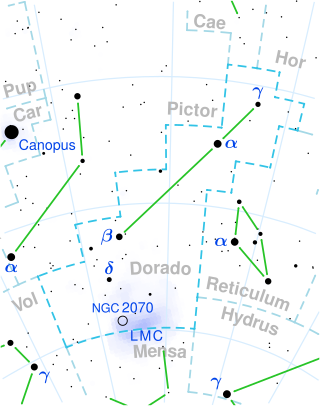Top Qs
Timeline
Chat
Perspective
Pi2 Doradus
G-type giant in the constellation Dorado From Wikipedia, the free encyclopedia
Remove ads
Pi2 Doradus, Latinized from π2 Doradus, is a solitary star[12] located in the southern constellation Doradus. It is faintly visible to the naked eye as a yellow-hued point of light with an apparent magnitude of 5.38.[2] The object is located relatively close at a distance of 277 light-years based on Gaia DR3 parallax measurements, but it is receding with a heliocentric radial velocity of approximately 9.1 km/s.[5] At its current distance, Pi2 Doradus' brightness is diminished by 0.27 magnitudes due to interstellar extinction[13] and it has an absolute magnitude of +0.78.[6]
Pi2 Doradus has a stellar classification of G8 III,[4] indicating that it is an evolved G-type giant star. It is a red clump star that is currently on the horizontal branch—fusing helium at its stellar core.[3] It has 1.8 times the mass of the Sun[7] but, at the age of 1.61 billion years,[9] it has expanded to 9.84 times the radius of the Sun.[7] It radiates 51.1 times the luminosity of the Sun from its photosphere at an effective temperature of 4,919 K[7] Pi2 Doradus is metal deficient with an iron abundance of [Fe/H] = −0.26 or roughly 55% of the Sun's.[7] Like many giant stars Pi2 Doradus spins slowly, having a projected rotational velocity lower than 2 km/s.[8]
Remove ads
References
Wikiwand - on
Seamless Wikipedia browsing. On steroids.
Remove ads

